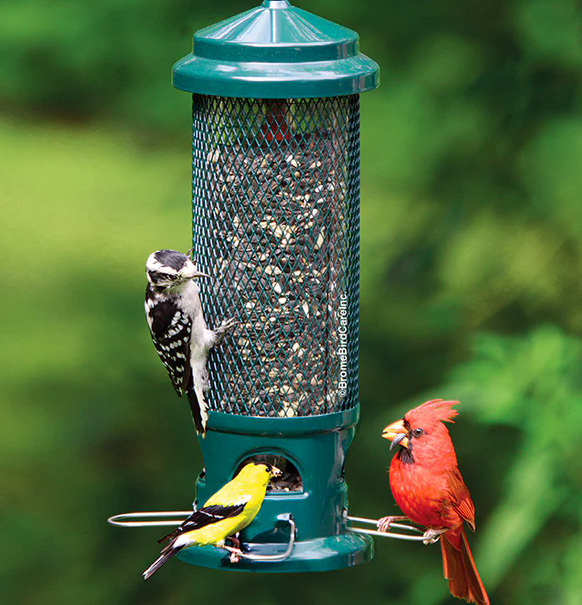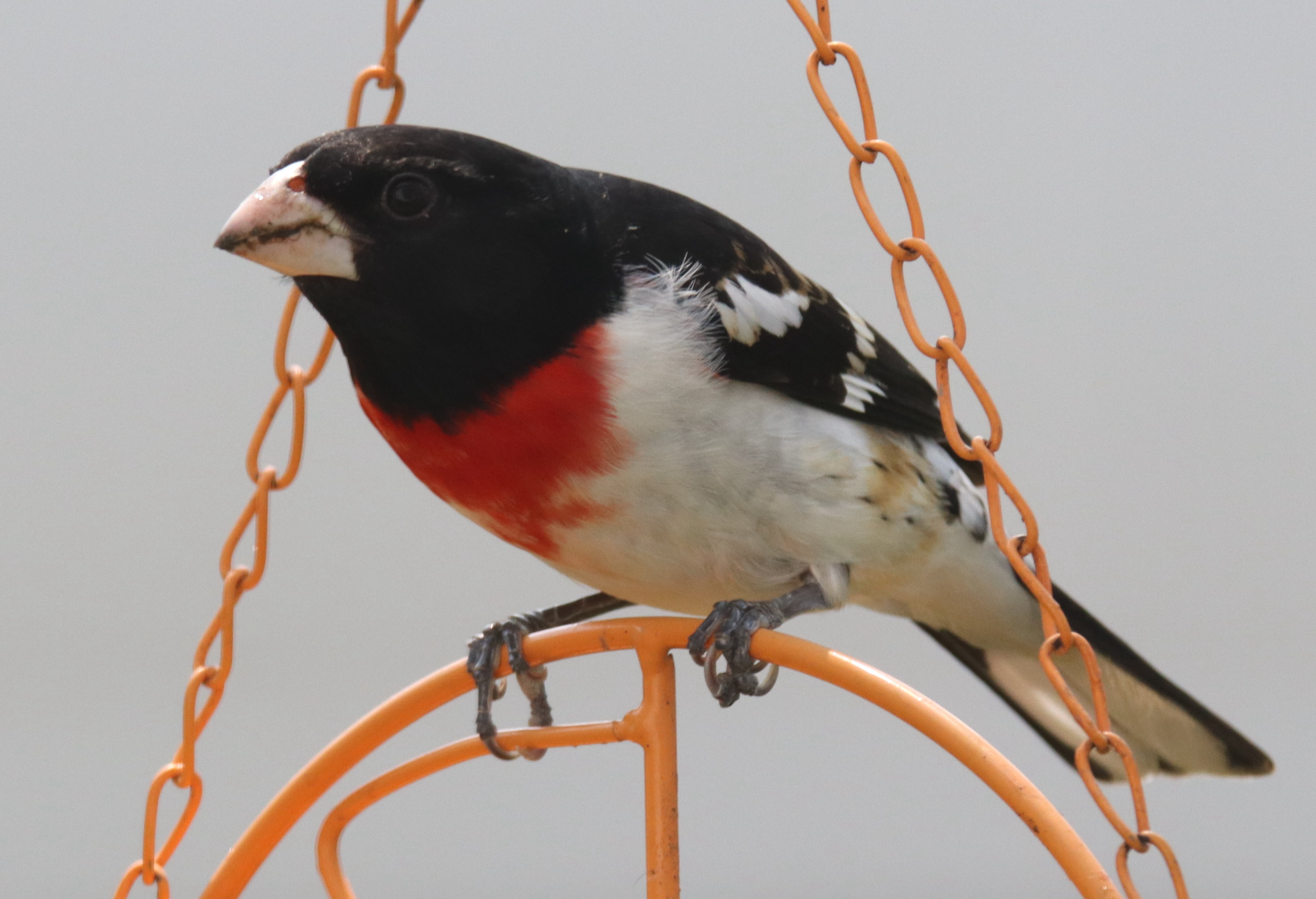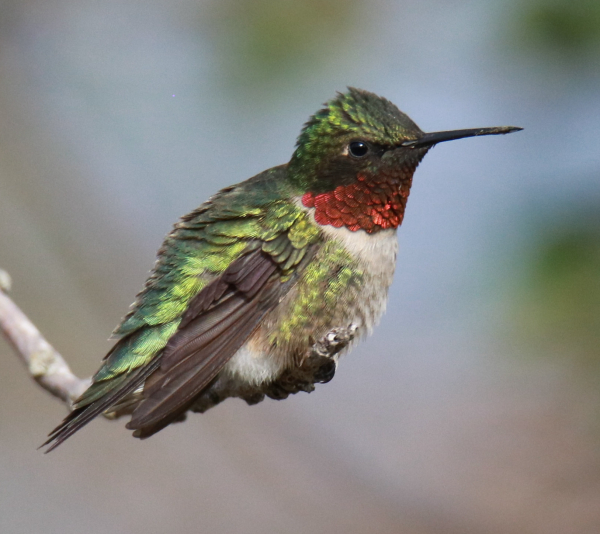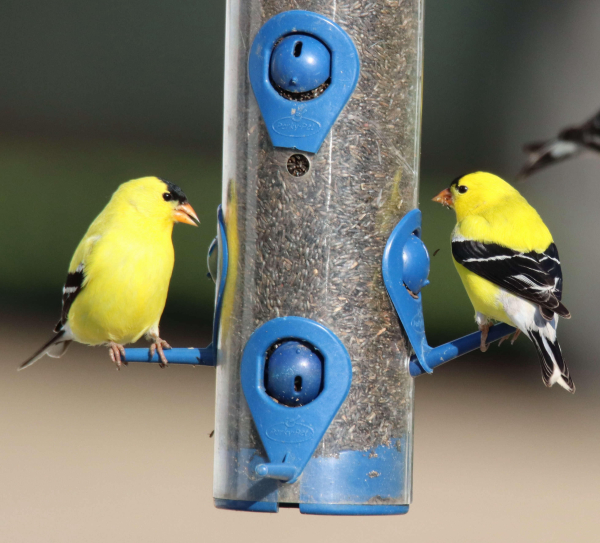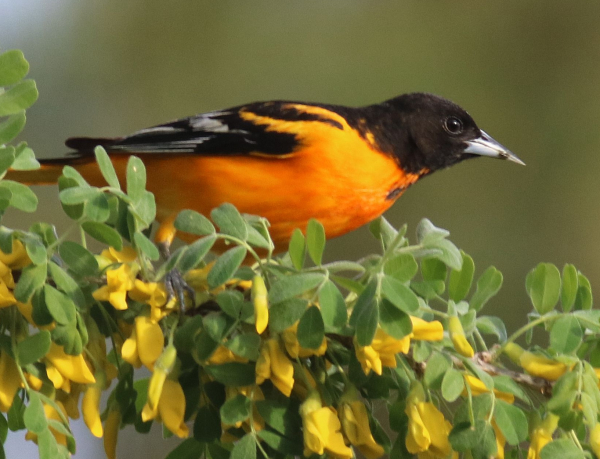Feeding Station Photo Opportunities
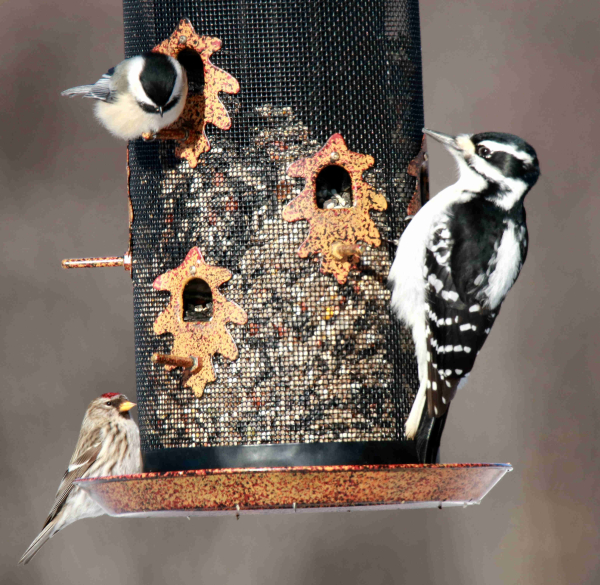
A return trip to the one of America’s best cold weather birding “hotspots” provided another opportunity to photograph at a variety of feeders and feeding stations. The Sax-Zim Bog offers birders what seems like unlimited feeding stations for us to photograph at – at least more than I have been able to visit in a single day. But I had my sights set on photographing at 4 primo feeding stations, and they kept me plenty busy, especially because I bounced back and forth between what turned out to be my 2 favorites of the day – the Admiral Road feeding station and Mary Lou’s feeding station – and these 2 sites are very different.
Admiral is a rather primitive feeding station, set up at what seems like a random wooded location along a backwoods road. It includes a few suet feeders, a couple extra-large sunflower tube feeders, and a couple hanging wooden platform feeders – all nestled along the edge of a dense woodland. It’s normal to park on the edge of the road there, picking a preferred location with the direction of sunlight and the birds in mind – morning provides the best sunlight direction at the Admiral feeders. Almost all vehicles on this road are birders, and even they are few and far between, making this a nice feeding station to spend some time photographing birds that visit.
Pine Grosbeaks and Canada Jays were the stars at the Admiral Road feeding station, although you were just as likely to photograph these birds on perches away from feeders as at the feeders themselves – and to have that option was a plus. This particular feeding station is also considered to be the best location to see Boreal Chickadees in Minnesota, and hence, the best place to photograph them. But alas, no Boreals for me during either of this winter’s visits. There were plenty of Black-capped Chickadees though, and nearly as my Common Redpolls. I also appreciated a Hoary Redpoll in 1 flock, and there was almost always 1 to 5 woodpeckers in sight – Downys and Hairys.
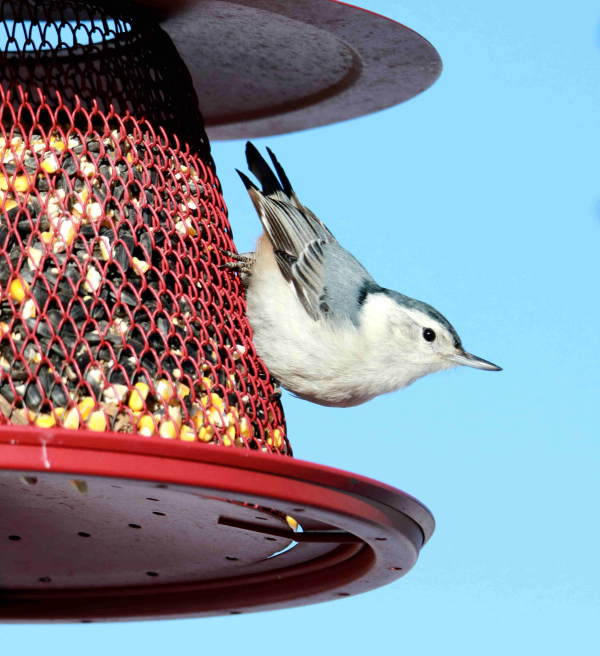
Frigid Camera Factors
Having planned my trip under the prediction of a sunny day at the Bog, there was indeed abundant sunlight from sunrise to sunset – a necessity for good photography in my book. Photographing the Northwoods feeder birds was relatively fast-paced with constant movement among the feeder visitors. But what made this day of photography very abnormal was the ultra-frigid temperatures that played havoc with my camera battery, and with my camera and lens autofocus system – at least I think it was due to the deep freeze.
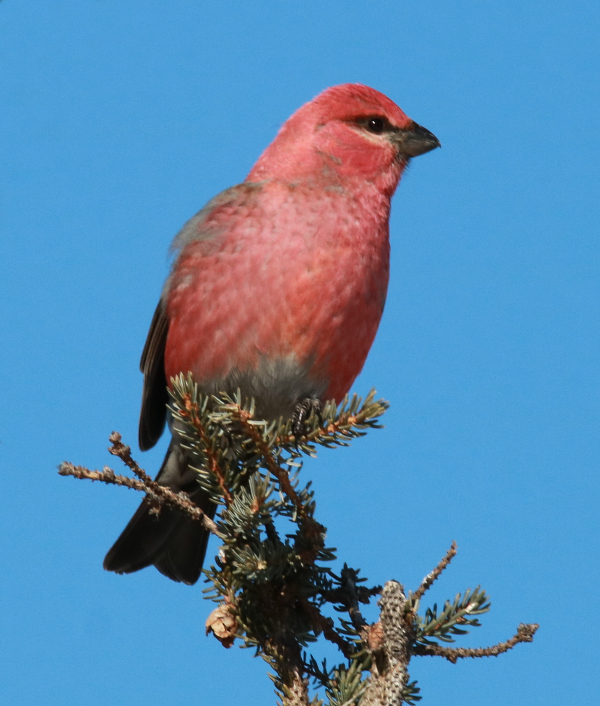
I often like to use my vehicle as a mobile photo blind, even at my own feeding station, and that was a necessary part of photographing last Thursday with polar temperatures in the minus 30s after sunrise and only “warming” to zero by early afternoon. Photographing outdoors was essentially impossible for more than a few minutes at a time, and unwarranted at the 2 feeding stations where using your vehicle as a blind was a perfect plan to keep from affecting the birds’ behavior and keeping as warm as possible for as long as possible.
The morning photo sessions were dictated by how long I could remain “comfortably cold” with the window open and the engine (and heater) turned off – 2 important requirements to photographing from my mobile blind. Periodically, when the interior of the van became too cold and the birding action was subdued, I would close the window and start the engine to warm up again – until the next small flock of Pine Grosbeaks or a Canada Jay appeared with the potential of providing photo opportunities.
I continued photographing at the Admiral feeding station until I needed to recharge my camera battery, then drove to Lou’s, which took about 20 minutes and provided time to warm the interior of my vehicle again and recharge the camera battery using an adaptor that converts 12 volt power from my vehicle to 120 volt power to my camera battery charger. I would enjoy observing and photographing a while at Lou’s, then return to Admiral to photograph about an hour before retracing my drive to Lou’s and recharging my camera battery again and getting the vehicle warmed up. The biggest reason for the back and forth was to take advantage of photographing Pine Grosbeaks at Admiral, while checking back to Lou’s periodically with the hope of intercepting Evening Grosbeaks there; and there was always the chance of seeing other Northwoods winter birds along the way.
Regarding the cold’s effects on the autofocus, I quickly realized it was necessary to focus my zoom lens manually on birds, which was considerably harder due to the need to keep medium-thick gloves on my hands and fingers. I missed some photo opportunities because I couldn’t feel the focus ring with gloved fingers at times, or because it was hard to pinpoint the true focus point manually. Even with gloves, I needed to warm my fingers at times by pulling my hand into a fist within my gloves. Aside from the frigid factors, I enjoyed plenty of opportunities to photograph a variety of birds in excellent sunlight conditions.
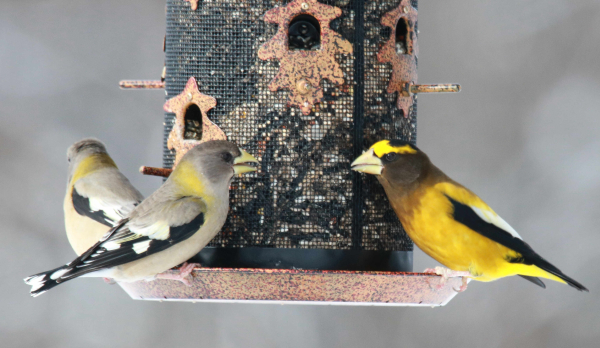
Pine Grosbeaks Among the Pines
The Admiral Road feeding station proved to be the best photography location for the day, especially due to the periodic visits by Pine Grosbeaks that arrived in small flocks of 6 or 8, or just 2 at a time. These interesting grosbeaks didn’t linger long, but in 10 or 15 minutes another group would suddenly appear. The Pine Grosbeaks were always very sneaky, with a couple birds seemingly slipping into the open from the cover of background trees, or suddenly appearing perched atop a tall pine tree, only to be joined by others. They kept me alert at all times as I hoped for a few good images, and not having been around Pine Grosbeaks much before, I found them to be most interesting birds with distinctively sweet high-pitched calls.
From an initial high perch, the grosbeaks seemed to be especially wary as they worked their way downward through the forest edge, perching at successive perches until eventually reaching a feeding location – often on the snow covering the ground below a feeder, or on a platform feeder to munch on black oil sunflower seeds. Of course, I made the most of every opportunity to photograph the Pine Grosbeaks as they moved from perch to perch to feeder to snow-covered ground. All the birds were interesting though, and it was great fun to watch their behaviors and interactions, trying all the while to take photos of all the species that availed themselves before me.
Feeder Photo Tips
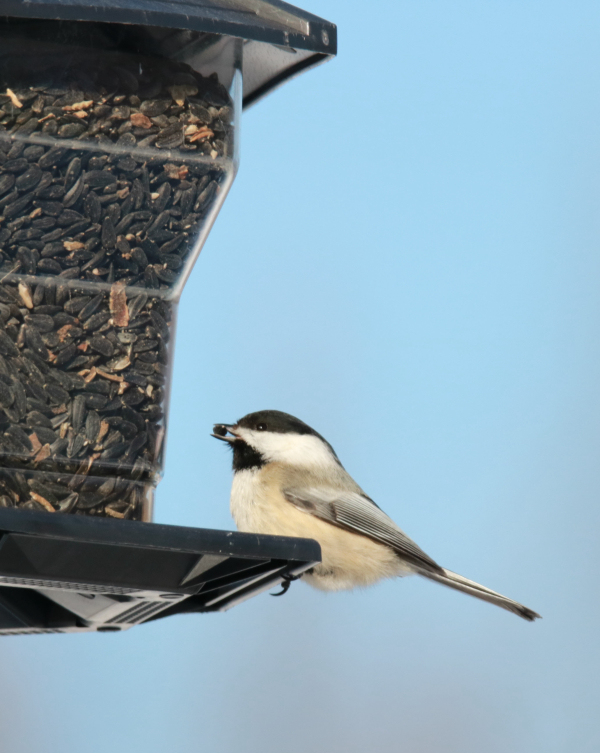
Whether you are photographing feeder birds at home or at a public-access feeding station at a nature center or wildlife refuge, there are a number of things to keep in mind, and many good techniques to use while you photograph the action.
– Using a zoom lens is a definite plus when photographing feeder birds.
– A zoom lens allows you to compose photos through the viewfinder, zooming in and out.
– Keep the sun at your back, so the sunlight illuminates your subject as directly as possible.
– Your shadow is a good indicator of the direction of the sunlight; try to keep your shadow pointing at your subject as best you can.
– Speaking of shadows, be aware of shadows on the bird you are photographing and adjust your position to avoid shadowing when possible.
– Brace your camera lens whenever possible to make it the most stable.
– Hold your breath whenever you take a photo to reduce any body shake.
– Lightly squeeze your finger down on the shutter release button to reduce any jerky motion.
– Don’t get too close; allow birds to feed and behave naturally.
– Be aware of the background of your photo. Try to eliminate distracting elements from view, which may be a simple matter of taking a step right or left in some cases to get a clearer background.
– Don’t use automatic settings on your camera. The aperture-priority (Av) setting is always the best mode for wildlife photography.
– Try to anticipate the next move of the birds you are photographing.
– Be prepared to photograph that action.
– Periodically, look at a few photos on the small LCD screen on the back of your camera to check the lighting and other aspects of the photos you have taken.
Use your vehicle as a mobile photo blind when applicable, convenient, or necessary.
– Stay inside your vehicle to make birds less wary.
– Turn off your engine when photographing to eliminate any vehicle shake or sound.
– Brace your camera lens against the window frame to help eliminate any body shake.
– Use your mobile blind to reposition as needed to improve the background in your photo frame, avoid shadows, or get a better angle on a feeder or other perches.
Personal Tech

My digital camera was fitted with the Tamron 150-to-600mm zoom lens, which provided a lot of opportunity to adapt to different feeder locations and birds that perched nearby. I use the Aperture-priority (Av) setting on my camera, then preset an aperture of f8, which resulted in a shutter speed of 1/800 to 1/2000 when using an ISO of 400. However, when photographing a bird against the open blue sky during midday, I found the birds were being over-exposed, which bleached out their colors on some photos, so I increased the aperture to f10 to try to reduce the amount of sunlight affecting the photo, and that seemed to work better. Toward the end of the day, as the light intensity faded, I increased my ISO setting to 800 and used an f7 aperture to increase the light sensitivity and keep my shutter speed as fast as possible (within reason).
In addition to the Admiral Road feeding station and Mary Lou’s feeders, I checked the Zabin feeding station a couple times, and spent the end of the days Wednesday and Thursday photographing at the Welcome Center, which is nestled in the woods surrounded by 8 or 10 feeders. The Welcome Center’s feeders attracted plenty of interesting birds, including Pine Grosbeaks and Red-breasted Nuthatches, but most of these feeders required photographing while standing outdoors, which was not an option for me during the early hours of Thursday due to the frigid temperatures. Even during late afternoon, I could only stay outdoors 15 minutes or less at a time, emphasizing my earlier choices of photographing from my vehicle at Lou’s and the Admiral feeding station.
Of course, much of the above photo description is related to the extreme elements I was affected by during my recent visit to the Sax-Zim Bog, which in hindsight was a rather desperate and somewhat dangerous thing to do under the influence of the polar dive in temperature. But many of the photo topics are relevant when photographing at almost any bird feeder or feeding station, as well as in the field.
We at The Birding Wire have provided more general information about how to get the most out of photographing at your feeders in the past, which we will continue share periodically in future issues. With that in mind, we thought a look at a mix of extreme birding and feeder photo techniques would offer a unique insight to an exciting mixture of field birding and backyard birding that emphasizes that these activities are true elements of the overall activity we all enjoy so much – Birding!
I rank the Sax-Zim Bog as one of the best Northwoods birding “hotspots,: and the work of the Center and its staff, volunteers, and feeder-hosting neighbors most very impressive – especially considering they have only been active for a dozen years. I also wanted to point out what a great effort the Friends of the Sax-Zim Bog have been making to gain the interest and participation of many local residents who generously welcome birders to view and photograph birds on their properties and in their yards.
Likewise, the Friends and generous contributors have provided a central point for birders to visit by constructing the Welcome Center, its feeders, and hiking trails, while providing excellent information sources such as the birding maps of the Bog and online information. To learn more about the Sax-Zim Bog and view a map of the region that includes the location of public-access feeding stations, you can refer to Friends of Sax-Zim Bog (saxzim.org) Most of all, enjoy the birds that visit your feeders, and the photo opportunities they provide – and stay warm!
Share your bird photos and birding experiences at editorstbw2@gmail.com


